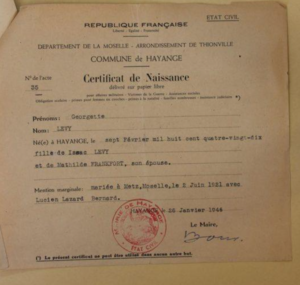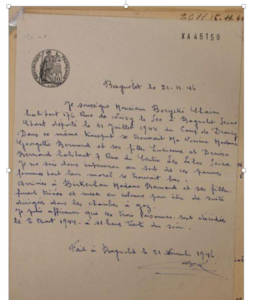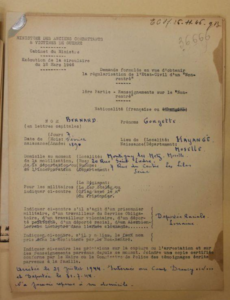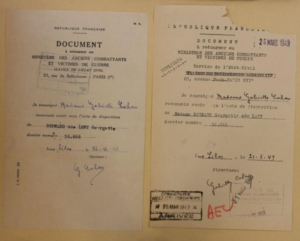Georgette BERNARD, née LEVY, 1890 – 1944
About us
We are a group of six 12th grade students from the Galilée high school in Combs-la-Ville, in the Seine et Marne department of France. As part of our civic and ethical education class, we became involved in the “Convoy 77” project. Our history and geography teacher, Ms. Surget, assigned us the task of compiling the biographies of Georgette Bernard and her two daughters.
As part of our project, we had the opportunity to go to the Shoah Memorial and the Pantheon, both in Paris. We are also intending to visit Auschwitz if circumstances permit.
The difficulties that we encountered
Before we present the biographies of Georgette Bernard and her two daughters, Denise and Lucienne, we feel we should point out that we were faced with a number of difficulties due to a lack of source material!
The Convoy 77 association provided us with 13 official documents concerning Georgette Bernard, 10 for Lucienne and 9 for Denise. Among these few documents, we were lucky enough to find a witness statement from another deportee, Chaïm Borycky, certifying that the three women had been selected to go to the gas chamber as soon as they arrived in Auschwitz. We then contacted the town halls in Hayange (their place of birth) and Les Lilas (where they last lived), but we came up against a lack of information there too. The Lilas town hall gave us the number of the veterans’ association, which we contacted, but to no avail, since they did not call back.
We managed to contact the researcher Alexandre Doulut, via our teacher, to tell him of our dismay at the lack of information about this family.
He explained to us that unfortunately we had little chance of finding any further documents about Georgette Bernard and her two daughters. The reason given was that they were French deportees who had been arrested by the French police. This explains the absence of records, because after the war the police destroyed the all records that they had kept on Jews during the Occupation.
We also tried to track down Gabrielle Cahin, who lived at 7, rue du Centre in Les Lilas in 1946, and who had contacted the Ministry of Veterans’ Affairs, but to no avail. We also discovered, from the documents provided by the Convoy 77 association, that no one had ever requested that the family be recognized as having been political deportees, which is unusual, according to Mr. Doulet and Ms. Surget.
We were upset by this research (and the lack of documents). How could we give back an identity to these three women and tell the story of their family when there were no records? It is almost as if they had never existed. They were on the last large convoy to Auschwitz and yet have only a few lines in their biographies. It’s awful!
Georgette’s biography
Georgette Bernard was the daughter of Isaac Levy and Mathilde Frankfort. She was one of a eight children.
They were five other girls: Yvonne, Sarah, Marcelle, Alice, and Gabrielle, who was born on October 17, 1895 in Hayange, in the Moselle department of France, and died on August 19, 1986 in Compiègne, in the Oise department.
There were also two boys: Gilbert, born on July 11, 1891 in Hayange, who got married in 1926 in Briey in the Meurthe et Moselle department. He was a salesman and had two children. He died of an illness on April 12, 1940 at the Bridoux Hospital in Metz. The second brother, Léon, who was a merchant, was born on October 14, 1900 in Hayange and died on September 2, 1934 in Metz.
Georgette was born on February 7, 1890 in Hayange [1]. She was a French citizen.
She got married in Metz on June 2, 1921 to Lucien Lazard Bernard. He was a merchant, a livestock merchant to be exact. He was born in Augny, in the Moselle department, in 1880. He was the son of Léon Bernard and Camille Cahen. He had a sister, Henriette Bernard, born on October 15, 1887 in Augny and died on November 4, 1972 in Metz.

Georgette and Lucien had two daughters. Lucienne was born on February 22, 1922 and Denise on March 18, 1926 in Montigny-Lès-Metz.
Lucien Lazard Bernard died in Montigny-lès-Metz in 1940.
Georgette, now widowed, moved to the Paris area to be near her sister Gabrielle Levy, married name Cahin. She lived at 7, rue du Centre in Le Lilas, in the Seine-Saint-Denis department.
She was arrested on July 29, 1944 and imprisoned in Drancy camp[2]. She was deported on racial grounds on July 31, 1944, on the last of the large convoys: Convoy 77[3], to Auschwitz[4] in Poland.
She was gassed on arrival, together with her two daughters, on August 2, 1944, as evidenced by a handwritten testimony by Chaïm Borycky[5], a Convoy 77 survivor.

On November 21, 1946, Gabrielle Cahin, who was living in Le Lilas, made a request to have Georgette declared a “non-returnee”[6] The certificate of non-return was issued on November 26, 1946 and states that Georgette was from Lorraine and had been deported on racial grounds.

A certificate of non-return entitled wives and mothers who were left alone, with no income, to an allowance. To claim it, however, they had to provide proof that the person was missing. But in the case of Georgette and her daughters, there were no survivors. It therefore seems to us that this is why nobody ever applied for them to be officially acknowledged as having been political deportees.

Georgette Bernard’s name is inscribed on the wall of names at the Shoah Memorial in Paris.[7]
We also found her name on the war memorial in Hayange, where she is listed as having died during deportation.

[1] Document provided by the Convoy 77 association.
[2] Drancy camp: Drancy was used as an internment camp and assembly point for French Jews before they were sent to concentration camps and killing centers. Nearly 63,000 of them were deported from Drancy.
[3] Convoy 77 was the last of the large convoys (carrying 1306 deportees) from Drancy to Auschwitz. It left on July 31,1944
[4] Auschwitz-Birkenau was a major concentration camp and killing center in Poland. More than 1.1 million Jews were murdered there.
[5] Israël Chaïm Borycky, who was born in 1902, survived and returned from the Auschwitz camp. He wrote this witness statement on November 21, 1946
[6] From 1945 onwards, when it became clear that many deportees had “disappeared”, their families were encouraged to request missing persons certificates, which were then followed by legal decrees confirming the death, rather than the usual death certificates.
It was decided arbitrarily that the place of death would be given as the place where the future deportees had been interned (Drancy, Pithiviers etc), and the date was given as the departure date of the convoy, which was not correct in this case.
[7] The Wall of Names is at the Shoah Memorial in Paris. It is made up of three stone walls on which the names and birth years of 76,000 Jews deported from France by the Nazis, with the collaboration of the Vichy government, are engraved. It has recently been completely renovated.


 Français
Français Polski
Polski









